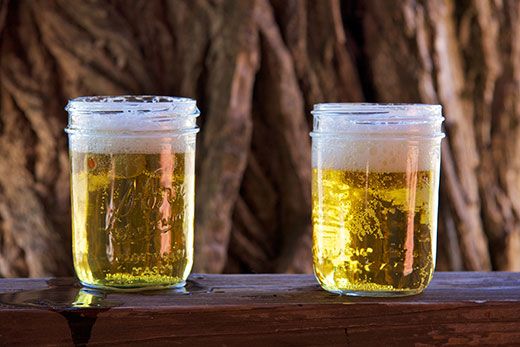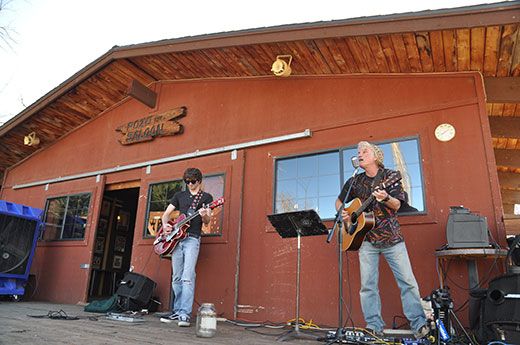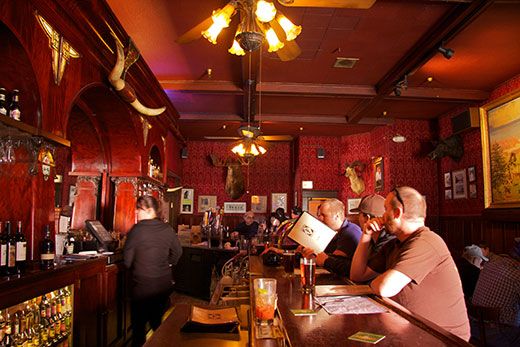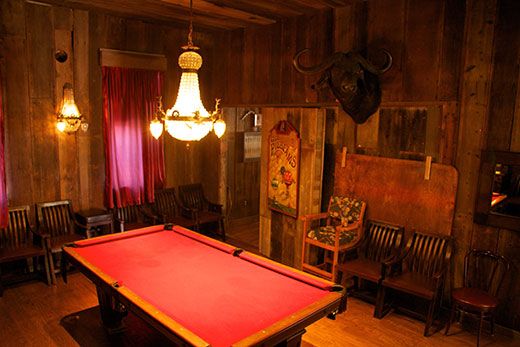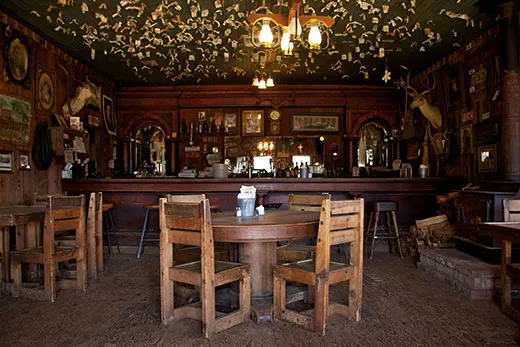The Historic Saloons of Central California
Not even rumors of apparitions could stop a group of eager drinking companions from investigating these ghost town bars
/https://tf-cmsv2-smithsonianmag-media.s3.amazonaws.com/filer/California-Saloons-Far-Western-Tavern-631.jpg)
The owner of the Pine Street Saloon in Paso Robles, California, had a problem and requested that my traveling companions and I drop by to solve it. His security cameras were picking up a presence, but was it a mere illusion or something more ghostly? With that end goal in mind, our six-man entourage embarked on what just may be the most authentic and doable old-school saloon tour on the West Coast: a journey from the damp desires of Cold Spring Tavern in the hills above Santa Barbara to the Prohibition-beating trapdoors of the Elkhorn Bar in San Miguel near the Salinas River roughly 100 miles north, with more ghost legends, dollar bills tacked to ceilings and animal heads on walls than you can point your dowsing rods at.
The Pine Street Saloon wouldn’t be the only place where we’d find a use for those rods¬—lent to me by someone who claimed to have used them to rid his childhood home of ghouls years before—and the “ghost meter” purchased on eBay. Our visits to a handful of Santa Barbara and San Luis Obispo county’s longest continually ale-slinging establishments would indicate that ghost stories may be as old as the saloons themselves.
The Stagecoach Route
Our apparitional adventure kicked off bright and early Saturday, with a venison and buffalo chili omelet, coffee and perfectly spiced bloody mary at the Cold Spring Tavern, a stagecoach stop since the 1860s located in a shady, spring-fed canyon between downtown Santa Barbara and Santa Ynez Valley wine country. Though the tavern might be most heralded these days for its tri-tip sandwiches and raucous rock ‘n’ roll sessions every weekend, we were drawn to the secluded collection of cabins — from the transplanted Ojai jail to the “Road Gang House” where Chinese laborers slept while carving out the then-treacherous San Marcos Pass, to the creaky-floored main restaurant and roadhouse-style bar.
Following an old stagecoach route, we made a brief stop at Mattei’s Tavern in Los Olivos, only about a 15 minute downhill drive on Highway 154. Built in 1886 by the Swiss-Italian ranchero-turned-hotelier Felix Mattei as an inn and restaurant in anticipation of the coming railroad, today it is home to Brothers Restaurant, owned by cookbook authors and siblings Jeff and Matt Nichols. While spending a few minutes checking out the historic plaques and peering into the windows of the white-walled building, it wasn’t hard to imagine the locally famed Chinese chef Gin Lung Gin whipping up one of his dove pies for the hungry railroaders who’d stop at Mattei’s overnight during trips between Los Angeles and San Francisco.
Another stagecoach stop-cum-railroad station is the town of Los Alamos, about 20 minutes by car from Los Olivos up Highway 101. Compared with the rest of California’s increasingly modernized Central Coast, Los Alamos is proudly locked in yesteryear — or as one of my companions noted, “It’s like every other building here has the ‘established’ date posted on it.” That was certainly true for the 1880 Union Hotel, established, of course, in 1880, and today featuring 14 rooms to rent — all appointed with Victorian-era niceties — as well as a bar that was already quite lively by 11 a.m. on a Saturday. On tap was their 1880 Ale, an excellent blond beer (made especially for the hotel by the award-winning folks at Firestone Brewery, which was founded just a few miles away), as well as billiards in the enchantingly — some might say hauntingly — dark back room and shuffleboard in the front bar, where you can also order empanadas stuffed with beef, olives, and egg or bratwurst with sauerkraut from the saloon menu.
Though the friendly bartender said she personally had only heard of ghosts in the place, I was crossing my fingers for a sighting of Michael Jackson, who filmed the video for “Say, Say, Say” here with Paul McCartney back in 1983, or perhaps Johnny Cash, who supposedly played the dining room in the 1950s. No dice on either front, but there was plenty to keep our eyes occupied, from the vintage signs (“check your guns,” of course, but also ads for corsetry shops and gunfighter paintings) and historic maps (showing the old stagecoach routes through the area) to the wacky collection of antiques — from snow skis to cellos — hanging on the walls. Upon reaching the bottom of our pints, we decided to leave our own mark in the saloon style, signing our names upon a dollar bill and employing a long pole to tack the greenback to the high wooden ceiling, where hundreds of other dollars flittered in the breeze.
Guadalupe’s Ghosts
Though most of my companions had lived in Santa Barbara County for more than a decade, almost none had visited Guadalupe, a small city along the banks of the Santa Maria River near the endless dunes of white sand where Cecil B. De Mille filmed The Ten Commandments and a mystic-minded community known as the Dunites lived in the 1930s and ‘40s. Taking in all the cowboy-hat-wearing Latinos who work the land in this rural northwestern corner of our county, a visitor to Guadalupe can be forgiven for thinking he meandered into a Mexican farming village. Well, at least it used to be that way, as the Guadalupe of 2011 seems almost deserted, no doubt due to the recession, but also because most of the main drag’s buildings are built with brick and have not been reinforced to withstand the next big quake. They sit empty, adorned with black-and-white signs to warn of the dangers of entry, an unfortunate sign that the whole town might slowly be turned over to the ghosts.
Inside the Far Western Tavern, however, there was a lively lunchtime crowd. Founded as the Palace Hotel in 1912, the establishment was taken over in 1958 by Clarence Minetti, who used to end his days of picking hay by chowing down on rib steak and spaghetti at the hotel’s restaurant for 65 cents. With his wife Rosalie and her cousin Richard Maretti, Minetti set about restoring the place’s former luster, keeping such elements as the mahogany bar (which some say came on a ship that sailed around the tip of South America), while changing the name to Far Western Tavern and adding the ranching-life touches (landscape paintings of cowboys working the hills, local cattle brands singed into the bar, etc.) to suit the new name. It’s been in the family ever since, attracting accolades for its Santa Maria-style barbecue from near and far, but even the Far Western is suffering from Guadalupe’s ailing brick bones. We were told over our Firestone Double Barrel ales that after many tears and tough decisions, the tavern will be relocating later this year from its birthplace to Old Town Orcutt, a little neighborhood a few miles to the south where there’s a food, drink and entertainment renaissance underway.
But we weren’t there to cry in our beers, so after snacking on some crispy mountain oysters (fried calf testicles, which were cheap, plentiful and fried-food tasty), we informed our servers of our ghostly mission. “Every time I have to go upstairs alone, I say ‘Jesus loves me,’” responded our bartender immediately, piquing our interest with tales of slamming doors and cold gusts of air when no windows are open. The manager, Barbara Abernethy — who’s the niece of Clarence Minetti and has worked at the restaurant since 1974 — relayed stories of noses being touched and ankles being grabbed, admitting that some “professional” ghost hunters had repeatedly investigated the establishment, finding the ghosts of children and a peg-leg man as well as “negative energy” near the upstairs bathroom. When they showed Abernethy their audio and video recordings, which revealed voices and orbs and other unexplained oddities, “It scared the crap out of me,” she said. “I get the chills now thinking about it.”
Minutes later, my friend was circling the upstairs with his ghost meter in hand, suddenly stumbling upon a spot above a table near the middle of the room where the device began beeping steadily. I snagged the dowsing rods and the metal sticks reacted as they were supposed to upon finding an anomalous energy field, swinging slightly open. There’s a significant amount of user error possible with the rods, so when I followed the instructions on communicating with the ghosts — they swing inward for yes, and outward for no, the lore goes, but you can’t ask about love, money or the future — I did so with a healthy degree of skepticism. But as the rods swang to and fro, something about the situation felt curiously authentic, as if we’d tapped into another world for a brief second. Or maybe the beer was finally starting to get to me.
Sippin’ SLO
The second-longest operating bar in all of California is in San Miguel, a tiny town north of Paso Robles of under 2,000 people that popped up following the 1797 founding of Mission San Miguel, where the vineyard-tending padres kicked off the region’s now dominant winemaking industry. Located on the one main drag of Mission Street, the Elkhorn Bar, established during the gold rush year of 1853, is both the predecessor and sole remnant of a once freewheeling strip, where — according to owner Gary Brown — “14 bars and 13 brothels” served the soldiers of the nearby Camp Roberts during the run-up to World War II. “For some of those guys, this was one of the last places they ever were,” said Brown, who bought the bar about five years ago and has set about reminding everyone of its history.
That goes back to even before the days of Jesse James, who came to hide out with his gentlemanly uncle Drury James and soak his robbery-related wounds in the nearby hot springs, and extends through Prohibition, when the Elkhorn’s front was a barbershop and patrons would toss their hooch through the still existing trapdoor into the cellar when the cops arrived. Today, there are antique guns on the walls, framed newspaper clippings from World War II across from the bar, modern day moonshines for sale, and constant ghost tales to entertain ale drinkers between sips.
One patron, without prompting, explained that he’d seen wine glasses fly across the room and crash into the corner, then the bartender relayed a story about a woman who went down into the cellar to find a table full of Old West apparitions playing poker, and then Brown — who showed us the said cellar — explained that many folks had seen a man in olden dress wander across the back room, where the stage is now. And then there were the multiple occasions of phantom grabs of posteriors, as various people have reported being touched down low. “There are always guys pinching ass around here,” said Brown with a laugh, “but those times, there was no one around.” Fittingly freaked out, we fled the otherwise welcoming Elkhorn to our final destination for the evening, and the genesis for this entire trip, the Pine Street Saloon, just off the main square of downtown Paso Robles.
Owner Ron French has been vexed by the “supercharged dust particles” (his words) that his night vision security cameras had been picking up. “To me, I’m not a ghost believer,” he said early on in our correspondence, “but I have no explanation for this.”
First opened by Ron’s mother, Pat French, in 1971, the Pine Street Saloon ditched its old location in 2002 to move into the circa 1865 building next door. That was just in time to avoid the massive Paso Robles earthquake of 2003, which knocked down their old brick building but only tilted their new wooden structure. French, it turns out, might just be the most hospitable saloonkeeper on the planet, having refurbished the upstairs brothel rooms into a boardinghouse of sorts to accommodate overly inebriated guests and purchasing a limousine to drive such patrons home for free, so long as they’re within Paso Robles’ city limits.
After some early experiments with candles and cameras led by French, our crew wasn’t super convinced that there was anything too supernatural going on upstairs at the former brothel, so we explored Paso Robles on foot, eventually taking in pizza and some rounds of bowling before returning to the Pine Street around midnight. The next morning, I managed to yank out the dowsing rods, but we were in a hurry to hit the last three destinations on our tour, so skipped town before finding any answers to Ron’s supercharged dust problem.
Take the Long Way Home
Once a centrally located hub with general store, hotel, blacksmith shops, numerous residences and its own school district along the Butterfield Overland Mail stagecoach route — which connected the San Joaquin Valley to the San Luis Obispo County coast — Pozo is now on the road to pretty much nowhere, with just a fire station and saloon left over, making it about as purely Old West as it gets these days. The Pozo Saloon, founded in 1858, still serves olives in its beer, and today hosts on its back lawn some big-time concerts, from Snoop Doggy Dogg to Willie Nelson. On our visit, the owner Rhonda Beanway and her son Levi were busy working the grounds and cooking up delicious blue cheese and mushroom burgers in the kitchen, but chatted it up with us as our group worked its way through a gallon of beer, served in a big jar, and listened to the live three-piece rock band out back. “It’s kind of a hard sell to get people to drive this far,” said Rhonda, who purchased the bar with her husband in 1984 when the previous owners literally handed them the keys on their way out of town. “That’s why we started the concerts. You have to come with a specific purpose and then fall in love with it. But it is one of the last real things like that in San Luis Obispo County for sure.”
Properly back in the saloon saddle, we decided to brave the Pozo Summit road, a pretty easily passable dirt path through the Santa Lucia Mountains and down into the Carizzo Plain National Monument, where tule elk and pronghorn antelope frolic amid Chumash pictographs on a relict landscape that once typified the entire San Joaquin Valley. With clear, unimpeded views as far as the eye can see, the Carrizo is wickedly wondrous any time of year, but catching it in the green winter or the wildflower-popping spring just might change your life by reminding you that silent, solemn places still exist in our cluttered world.
We stuck to our last suds and some tasty cheeseburgers as the hour crept toward dark on this Sunday afternoon, and hit the road with a stunning sunset lighting the way. We pointed our cars home to Santa Barbara, and slipped into bed to enjoy what even the most adventurous Old Westerner also sought: a good night’s rest.
